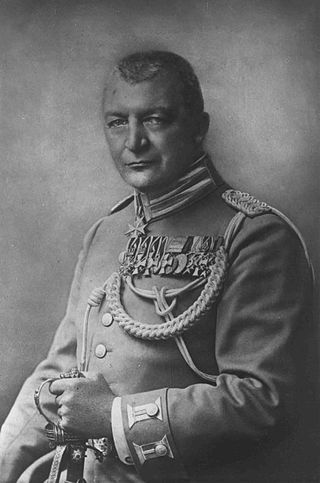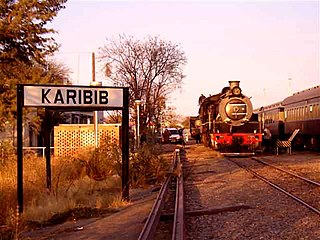Related Research Articles

Omaruru is a town in the Erongo Region of central Namibia. The town has 14,000 inhabitants and encompasses 352 square kilometres (136 sq mi) of land. It is situated near Mount Erongo, on the usually dry Omaruru River. It is located on the main paved road from Swakopmund to Otjiwarongo. The name in the Otjiherero language means 'bitter milk', as Herero cattle herds used to graze on the local bush that turned their milk bitter.

Karibib is a town in the Erongo Region of western Namibia. It has 3,800 inhabitants and owns 97 square kilometres (37 sq mi) of town land. Karibib is the district capital of the Karibib electoral constituency. It is situated on the Khan River, halfway between Windhoek and Swakopmund on the B2, the main road between Walvis Bay and Johannesburg. The town is known for its aragonite marble quarries and the Navachab Gold Mine.

Otjiwarongo is a city of 28,000 inhabitants in the Otjozondjupa Region of Namibia. It is the district capital of the Otjiwarongo electoral constituency and also the capital of Otjozondjupa.

Usakos is a town on the banks of river Khan, 140 kilometres north-east of Swakopmund in the Erongo Region of Namibia. It is located on the B2, the main road between the Walvis Bay and Johannesburg. The town has 3,000 inhabitants and owns 58 square kilometres (22 sq mi) of land.

TransNamib Holdings Limited, commonly referred to as TransNamib, is a state-owned railway company in Namibia. Organised as a holding company, it provides both rail and road freight services, as well as passenger rail services. Its headquarters are in the country’s capital Windhoek.

Erich Victor Carl August Franke was a German military officer and last commander of the Schutztruppe in German South West Africa. Franke was born in Zuckmantel, Austrian Silesia. He was Bezirksamtmann in several locations in German South West Africa, especially Ovamboland and Kaokoveld. He was stationed at Outjo from 1899 until 1910, and was involved in several campaigns against native tribes who resisted German colonial rule. In the early phases of the Herero Genocide of 1904, he was dubbed "Hero of Omaruru", because of his victory over numerically superior Herero forces at Omaruru. He also had successful campaigns against the Herero at Okahandja and Windhoek.

Otavi is a town with 4,000 inhabitants in the Otjozondjupa Region of Namibia. Situated 360 km north of Windhoek, it is the district capital of the Otavi electoral constituency.

Rail transport in Angola consists of three separate Cape gauge lines that do not connect: the northern Luanda Railway, the central Benguela Railway, and the southern Moçâmedes Railway. The lines each connect the Atlantic coast to the interior of the country. A fourth system once linked Gunza and Gabala but is no longer operational.
The Otavi Mining and Railway Company was a railway and mining company in German South West Africa. It was founded on 6 April 1900 in Berlin with the Disconto-Gesellschaft and the South West Africa Company as major shareholders.

Windhoek railway station is a railway station serving the city of Windhoek, the capital of Namibia. It is an important station in the Namibian rail network, and it is run by TransNamib.

Okahandja railway station is a railway station serving the town of Okahandja in Namibia. It is part of the TransNamib Railway.

Karibib railway station is a railway station serving the town of Karibib in Namibia. It is part of the TransNamib Railway.

Swakopmund railway station is a railway station serving the town of Swakopmund in Namibia. It is part of the TransNamib railway network. Its IATA code is ZSZ.

Keetmanshoop railway station is a railway station serving the town of Keetmanshoop in Namibia. It was erected in 1908. when the territory was colonised by Imperial Germany. It is part of the TransNamib Railway, and is located along the Windhoek to Upington line that was inaugurated in 1915 and connects Namibia with South Africa. Keetmanshoop also has a junction to Seeheim and Aus, completed in 1908.

Kranzberg railway station is a railway station in Namibia between the towns of Karibib and Usakos. It is part of the TransNamib Railway. At Kranzberg, the railway line from Windhoek splits; one line continues westwards to Swakopmund and Walvis Bay, the other one continues north-eastwards towards Omaruru and Tsumeb.

Rail service in Namibia is provided by TransNamib. The Namibian rail network consists of 2,687 route-km of tracks (2017).

The history of rail transport in Namibia began with a small mining rail line at Cape Cross in 1895. The first major railway project was started in 1897 when the German Colonial Authority built the 600 mm gauge Staatsbahn from Swakopmund to Windhoek. By 1902 the line was completed.

Usakos railway station is a railway station in Namibia serving the city of Usakos. It is part of the TransNamib railway network. The station building is dilapidated but passenger trains still stop at Usakos.
The Swakopmund–Windhoek line was a main 600 mm narrow-gauge railway line in Namibia. It was built in 1897 and operated until 1990 when the route name was changed.
Otavi railway station is located in the mining town of Otavi in Namibia's central Otjozondjupa Region. It is served by a mostly freight railway and limited number of passenger service. The extension of the railway towards the east to Grootfontein is exclusively for freight service.
References
- 1 2 Dierks, Klaus. "The Development of the Namibian Railway Network. The Rail History Until the 1990s". www.klausdierks.com. Retrieved 19 November 2012.
- ↑ Namibia: Community Vandalizes New Railway Line (9 July 2012)